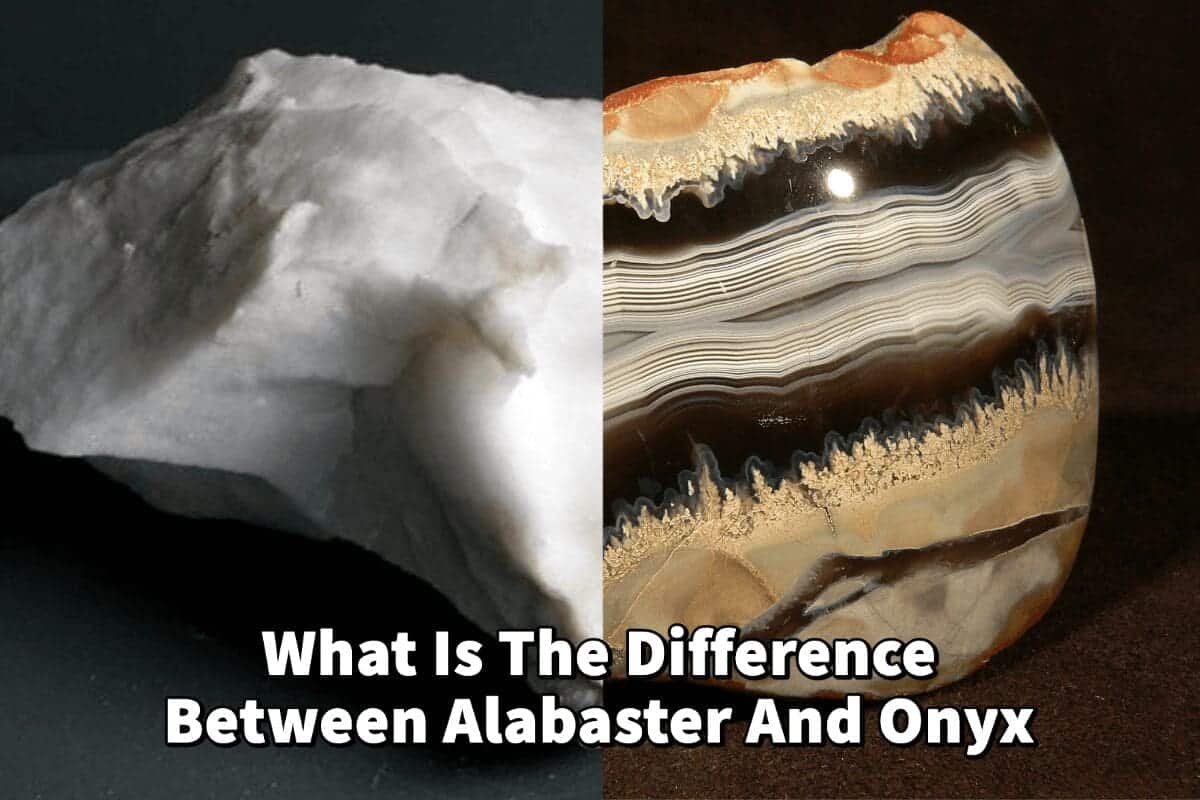Alabaster and Onyx may seem like similar products, but the truth is that they are pretty different and have different properties and uses.
The Alabaster is a soft, translucent stone, usually white with either black or brown veins or lines throughout the stone. Onyx is a much harder stone and is typically black and white. The Onyx stone would have a more layered effect than a look like Alabaster with thin veins or lines.
Table of Contents
- All About Alabaster
- All About Onyx
- Differences Between Alabaster and Onyx
- Alabaster and Onyx: A Tale of Two Stones – Exploring Their Shared Characteristics
- Frequently Asked Questions
- Related Content
All About Alabaster

Alabaster is a soft mineral or rock that has traditionally been used for carving due to how easy it is to cut. Because it is soft, it has been used for centuries and has many different uses.
In technical terms, Alabaster is a medium to hard gypsum or calcite mineral that is usually white and translucent. It has an excellent uniform grain. When Alabaster is put up to the light, you can see small refined natural grains of the stone shine through.
Most people agree that Alabaster has two kinds of stones: gypsum stone and calcite stone. Both of these stones look pretty similar.
Alabaster has been used for sculptures, figurines, and decorations for centuries. Alabaster has a transparent color and finishes, a stone used for lamps and lighting.
Also, because it is a porous stone, Alabaster can be dyed into any color or shade. The dyeing of Alabaster is a technique that has been used for centuries.
The purest of Alabaster is a snow-white material with a fine, uniform grain. But some alabaster can also have brown or yellow tones. Most people prefer Alabaster for its snow-white translucent nature.
Because Alabaster is naturally white, it can often be confused with white marble. But white marble is a much harder stone than Alabaster and does not have the same look or feel.
All About Onyx

Onyx is considered a silicate mineral chalcedony type of stone. Onyx is more similar to an agate than to Alabaster.
Both Onyx and Agate are varieties of chalcedony stone, but their main difference is in the bands or layers of the stone. Agate has curved bands to the stone, and Onyx has parallel bands.
The color of the Onyx bands is usually black and white. Because of the nature of the onyx bands, the term Onyx has been used to refer to Alabaster but only due to some similarities of the bands and not the minerals themselves.
The word Onyx is used with Alabaster to describe words as onyx-marble. The word onyx-marble is used for the calcite version of Alabaster.
Because the word onyx is used for the calcite version of the Alabaster, there can be some confusion between Onyx and Alabaster. The term onyx refers to the look of the alabaster stone and not the properties or hardness of the Alabaster.
Onyx and Alabaster are very different stones and have very different properties. Onyx is a hard stone usually cut into pieces for decoration, jewelry, or other uses.
Differences Between Alabaster and Onyx
There are many differences between Alabaster and Onyx. Here are some of the more notable differences:
- Type of Mineral – Alabaster is a gypsum or calcite mineral. Gypsum is one of the more common materials, but a calcite variety is also used. Onyx is a silicate mineral and is known as a crystalline stone.
- Hardness – Alabaster is a medium to hard mineral and is quite soft to carve. Onyx is a tough mineral and harder to carve. Onyx stone is much harder to carve than Alabaster stone.
- Overall Look – The two minerals do not look the same. Alabaster is mainly white unless dyed, and Onyx has prominently defined black and white layers. The Alabaster would be mainly white with veins or lines going through it. The Onyx would have more defined black and white layers. This is one of the main ways to tell the difference between these two minerals.
- Dyeing Properties – Alabaster is soft enough to be dyed in various colors. Onyx is not dyed but used in its natural state.
- Translucency – Alabaster has a lot of translucency, so it can be used for lamps and light shades. Onyx is either slightly transparent or completely opaque. The degree of how much you can see through the Onyx will depend a lot on the stone, whereas the Alabaster usually has a translucent nature.
- Colors – Alabaster is usually white with fine black or brownish veining or lines. Onyx has a black base with white layers.
- Uses – For centuries, Alabaster has been used for decorative purposes such as statues, windows, and all kinds of decorative elements. On the other hand, Onyx is used a lot to make jewelry or beads.
- Related Stones – Alabaster is many times thought to be a marble. But the truth is that Alabaster is much softer than marble and is only thought to be marble as they are the same as marble and have the same overall look. On the other hand, Onyx is related to an agate stone; it will have some of the same looks as an agate, where the colors are layered throughout the stone.
If you’re interested to see what type of alabaster or onyx products Mondoro Company can produce, we would love to talk to you. We have some magnificent bathroom sets that are made in natural alabaster stone.
Alabaster and Onyx: A Tale of Two Stones – Exploring Their Shared Characteristics
Alabaster and onyx, while distinct in their origins and individual properties, exhibit a fascinating array of similarities that have captivated artists, architects, and designers for centuries. Both stones possess unique features that make them highly valued in various fields, from sculpture to interior design.
This exploration into their shared characteristics highlights the subtle yet significant parallels between these beautiful materials, offering insights into their enduring appeal and versatility.
10 Similarities between Alabaster and Onyx:
- Translucency: Both alabaster and onyx are known for their translucence, allowing light to pass through them, creating a soft, ethereal glow highly prized in decorative applications.
- Historical Significance: Each stone has a rich history, having been used for centuries in art, architecture, and religious artifacts, showcasing their long-standing value across cultures.
- Fine Texture: Alabaster and onyx both have a fine, smooth texture that lends itself to detailed carving and polishing, making them ideal for intricate designs.
- Variety in Color: While traditionally recognized in certain colors, both stones come in a variety of hues, ranging from whites and creams to rich, veined patterns, offering versatility in design.
- Used in Lighting: Their ability to diffuse light beautifully makes both alabaster and onyx popular choices for creating lamps, chandeliers, and other lighting fixtures.
- Decorative Appeal: Both materials are highly regarded for their decorative qualities, often used as statement pieces in interior design due to their striking appearance.
- Softness: Compared to harder stones like granite or marble, both alabaster and onyx are softer, making them easier to work with but also more susceptible to scratches and wear.
- Symbolism: Each stone carries its own set of symbolic meanings and has been used in various cultural and spiritual contexts, reflecting their depth beyond physical beauty.
- Luxury Connotation: Alabaster and onyx are often associated with luxury and elegance, commonly found in high-end designs and sophisticated environments.
- Maintenance and Care: Both require careful maintenance to preserve their beauty, needing protection from harsh chemicals and excessive moisture, and benefit from regular polishing.
Alabaster and onyx, though unique in their own right, share a range of similarities that enhance their allure and functionality in various artistic and design contexts. Understanding these similarities helps in appreciating the versatility and beauty these materials bring to the world of design.
Find out more about how Mondoro can help you create, develop, and manufacture excellent home decor and home furniture products – don’t hesitate to contact me, Anita. Check out my email by clicking here or become a part of our community and join our newsletter by clicking here.
Mondoro gives out a FREE Lookbook to anyone interested. You can receive a copy of our latest Lookbook by clicking here.
Listen to our Podcast called Global Trade Gal. You can find it on all major podcast platforms. Try out to listen to one of our podcasts by clicking here.
Subscribe to our Mondoro Company Limited YouTube Channel filled with great videos and information by clicking here.
Frequently Asked Questions
What is alabaster?
Alabaster is a soft, translucent stone primarily composed of gypsum or calcite. It is known for its light-colored appearance and can be carved or used for decorative purposes.
What is onyx?
Onyx is a form of chalcedony, which is a variety of quartz. It is characterized by its banded or layered appearance and can come in a variety of colors.
What is the main difference between alabaster and onyx?
The main difference lies in their composition and appearance. Alabaster is a softer stone with a translucent quality, while onyx is a harder stone with distinct banding or layering.
Are alabaster and onyx equally durable?
No, onyx is generally more durable and harder than alabaster. Alabaster is relatively soft and more prone to scratches or damage.
Which stone is more commonly used in sculptures or carvings?
Alabaster is commonly used in sculptures and carvings due to its softness and ease of carving. Onyx is also used but is more often seen in jewelry and decorative applications.
Can alabaster and onyx be used for countertops or other functional surfaces?
Onyx is more commonly used for countertops and other functional surfaces due to its hardness and durability. Alabaster is less suitable for such applications due to its softness.
Do alabaster and onyx have similar patterns or veining?
Alabaster typically has a more uniform appearance with a smooth, translucent surface. Onyx, on the other hand, displays distinctive banding or layering patterns, often with contrasting colors.
Are alabaster and onyx natural stones?
Yes, both alabaster and onyx are natural stones that are formed over thousands or millions of years through natural processes.
Which stone is more expensive, alabaster or onyx?
The cost of both alabaster and onyx can vary depending on factors such as quality, size, and rarity. In general, onyx is considered more valuable and tends to be more expensive than alabaster.
Related Content
What is Alabaster? Alabaster for Home Decor Product Development
Production is about manufacturing goods from raw material to finished products. Productivity is considered part of the production process. Productivity is about how efficient a country or company is. Productivity is an economic principle; a formula is used to calculate productivity.
You can discover more by reading What is Alabaster? Alabaster for Home Decor Product Development by clicking here.
Natural Agate Stone Beads For Home Decor Products
Agate is a natural rock formation used as a decorative element for centuries. It can be found in many parts of the world, and there are many different kinds and colors of agate stone. In the Asia practice of Feng Shui, it can help us strike a balance in life and for good luck.
By clicking here, you can discover more by reading Natural Agate Stone Beads For Home Decor Products.

